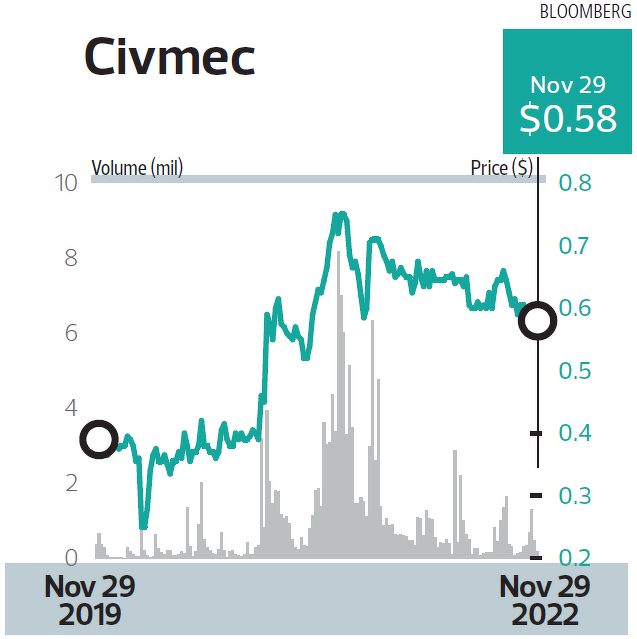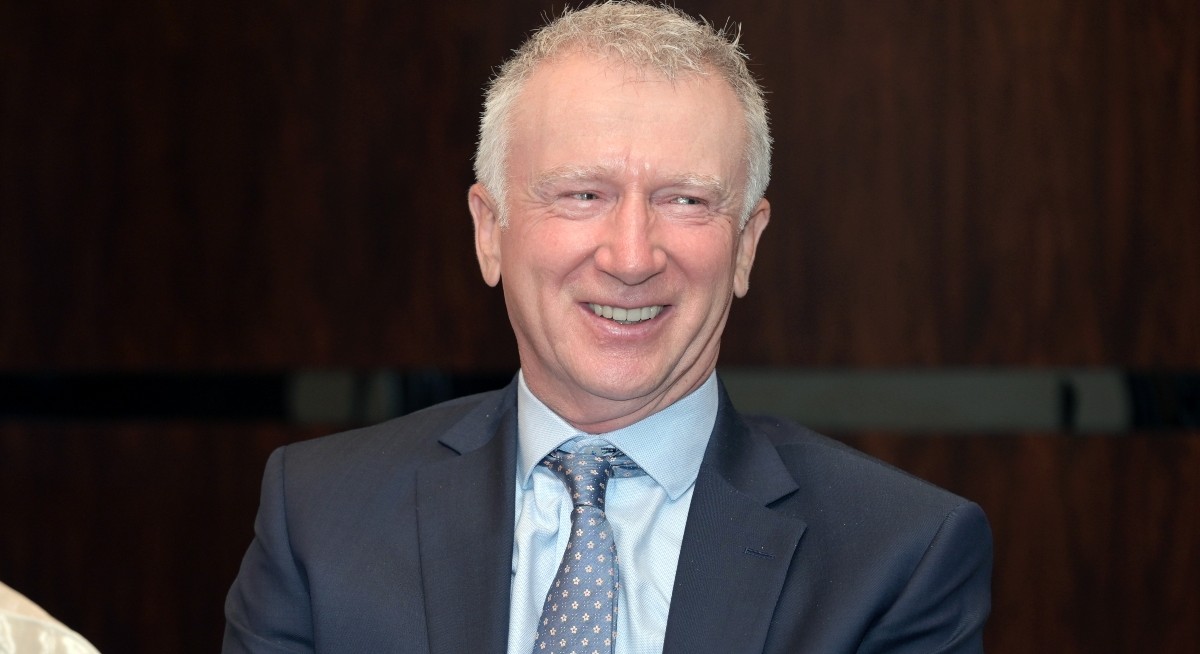With these environmental commitments, is Civmec concerned that the pipeline for projects like LNG platforms and oil rigs will dry up?
James Fitzgerald, executive chairman of Civmec, says major clients like oil and gas producer Woodside Energy Group and energy giant Chevron Corp are still proceeding with their expansion plans, which means there is “still a lot of work”.
Even if the industry turns toward clean energy sources like wind and solar farms, this does not mean that the company will see a fall in revenue just because it does projects for the oil and gas industry.
For example, Western Australia plans to close all coal-fired power plants by 2030 and transition to renewable and gas-fired energy.
Fitzgerald says that Civmec is well equipped to handle the transition as these are still construction projects at their core. Civmec can play a part by building solar and wind farms or upgrading the electricity grid too.
A major component in the green energy transition are batteries that can store power generated by renewable sources, so as to overcome power fluctuations and outages when weather conditions are not favourable.
Civmec has already built up a track record to this end. It has done work for chemicals company Albemarle Corp and Covalent Lithium’s lithium processing plants. More importantly, Civmec also gained experience with constructing ammonia plants and is ready to move into the hydrogen space if hydrogen plants come online. As such, Fitzgerald sees the green transition “as a positive, absolutely not a negative at all.”
See also: GRC doubles FY2025 earnings to $7.4 mil following acquisition of construction business
Another stellar showing
In its most recent 1QYF2023 ended Sept 30, Civmec reported net profit after tax rose 31.3% y-o-y to A$14.2 million ($13.06 million) on the back of revenue growth of 15.6% y-o-y to A$228.3 million.
This positive showing is a continuation of its stellar performance in FY2022 when earnings jumped 45.6% y-o-y to a record A$50.7 million while revenue rose by a fifth to A$809 million.
In line with better earnings, Civmec has declared a higher dividend of three Australian cents per share for FY2022, up from two cents in FY2021. In a clear sign of strong and ongoing business momentum, Civmec has grown its order book to over A$935 million as at Sept 30.
However, Civmec’s share price is down 12.1% year to date. As at Nov 29, it stands at 58 cents, valuing the company at $292.98 million. Fitzgerald is unfazed that the market has not recognised the company’s improved performance though. He notes that the whole market is down due to uncertainty over rising interest rates, geopolitical tensions and supply chain woes.
Having chaired the company’s AGM on Oct 28, Fitzgerald believes that his fellow shareholders “are pretty happy with us” and that they “understand where the market is”.
The higher dividends for FY2022 serve two purposes. “That was a thing that we did purely to reward our investors but also to encourage people to give us more [trading] volume and increase our share price,” explains Fitzgerald.
To stay ahead of Singapore and the region’s corporate and economic trends, click here for Latest Section
“It is very difficult to find a reason why our share price is where it is. If you look at any of the analysts’ reports, they all say we should be over $1,” he adds.
Civmec boasts an order book of about A$935 billion as at Sept 30 but besides simply bidding for projects, Civmec CEO Pat Tallon said in an earlier interview that Civmec aims to develop more recurring revenue streams by providing a wider range of maintenance services for its clients.
One such recent development is Civmec’s so-called IRATA (Industrial Rope Access Trade Association) certification, which provides maintenance services using specialised rope access capabilities.
The company explains that such services “are of particular interest” to clients performing maintenance work on existing infrastructure as they allow quick and cost-effective access to difficult-to-reach areas. With such certifications, Civmec believes it can grow its maintenance offerings.
According to Fitzgerald, the company’s proportion of recurring revenue is now around 16% to 18%, and the goal is to increase this proportion to 40% in about three years.
Fitzgerald says Civmec prefers to pursue this revenue stream of recurring revenue, rather than simply bidding for larger projects.
That is because he needs to hire more people with the right skillsets before planning to undertake larger projects, lest the company “compromises on the quality of delivery”. “The projects that we do now, we’re confident that we have the right people,” he explains.
Navigating geopolitics
Besides the environment, Civmec’s business is also buffeted by the winds of geopolitics. For example, when China and the US launched their “trade war” in 2018, the effect was immediate and noticeable. Businesses on both sides of the Pacific were hit, including farmers, financial markets and tech firms.
Throughout former Australian prime minister Scott Morrison’s tenure, tensions between Australia and China have risen, notably over the 2021 Aukus trilateral security pact between Australia, the UK and US.
With this backdrop, one of Civmec’s notable, ongoing projects is to help build 12 next-generation offshore patrol vessels (OPV) for Australia. The approved cost of acquiring these 12 OPVs, dubbed the Arafura class, and associated support systems are estimated to be A$3.58 billion.
Of this figure, a A$1.98 billion contract for the build and design of the OPVs was signed by the Australian government in 2018 with prime contractor Luerssen Australia, a subsidiary of German shipbuilder Lürssen.
Civmec’s share of the contract covers the supply of steel plates and piping for the first two of the new OPVs, which have since been built in South Australia by Luerssen Australia and its partner ASC. Civmec will build the hull sections for the remaining 10 vessels before handing over to Luerseen Australia to complete the OPVs at Civmec’s Henderson facility.
In Australia’s 2020 Force Structure Plan, Australia had planned for the acquisition or upgrade of up to 23 different classes of maritime vessels, with a total investment of A$168 billion to A$183 billion from 2020 until the completion of the Attack class submarine in the 2050s.
However, the 2021 Aukus trilateral security pact had seen the Attack class submarine project, done in collaboration with French firm DCNS (now known as Naval Group), cancelled.
Since Albanese took over the helm in Australia, the country has also embarked on its Defence Strategic Review, an independently-led review that will consider the country’s defence force posture and force structure.
With these developments, Fitzgerald is confident that there would still be “quite a lot of ships to be built”. He says that the original plan was to build major war vessels in Southern Australia, and minor war vessels in Western Australia. Civmec, with its Henderson facility constructing the OPVs, has experience in this area.
Back in 2016, Civmec acquired Australian engineering and shipbuilding company Forgacs Marine and Defence, which had built hull sections for Anzac-class frigates, and Hobart-class air warfare destroyers.
Fitzgerald believes that the company is “in a pretty good position to win some of this work.” After all, Australia, being a maritime country, will still need to build up its defences, especially with a larger maritime border.
“The country needs ships. It’s got a huge border around the country and a huge area to cover, and it needs to have the equipment to do it. So, I think it’ll just continue. As one job finishes, another job starts. I don’t see that changing,” says Fitzgerald.
Paving the way forward
Despite having interesting prospects from its existing businesses, Civmec is actively looking for new markets. Among its plans, Civmec wants to venture into building roads, and it is now in the process of obtaining the required accreditations for this venture, says Fitzgerald.
Under Australia’s National Prequalification System (NPS) for civil construction, contracts for the construction of roadworks and bridgeworks are categorised from R1 to R5 for roads, and B1 to B4 for bridges (R1 and B1 being the lowest level).
Fitzgerald says that Civmec can now handle projects of R2 rating for roads, and B3 for bridges but the goal is to get to R5 and B4 certification because once the company obtains those, it can “build any type of road infrastructure in the country”.
Fitzgerald expects this to be an area of growth Civmec can plunge straight into as its larger competitors are already raking in about A$14 billion a year building road infrastructure.
“We’re in the business of making things… our industry will go on for hundreds of years. Because they’ll always be a demand for what we do, and the world can’t survive without people like us,” says Fitzgerald.
“We’re in the business of making things… our industry will go on for hundreds of years. Because they’ll always be a demand for what we do, and the world can’t survive without people like us,” says Fitzgerald.




